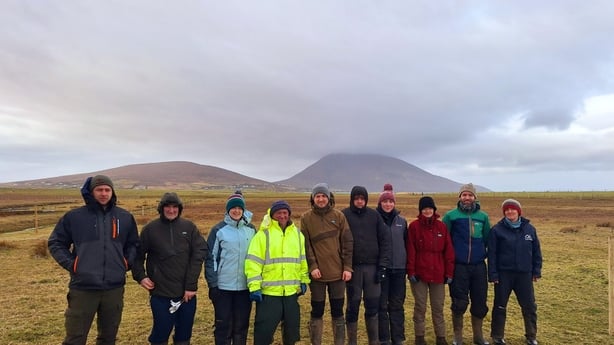A team of locals and conservationists have erected the largest temporary predation exclusion zone for wildlife in Ireland in Acaill, Co Mayo.
LIFE on Machair and Breeding Waders EIP teamed up to design and put up fencing of 1.6km to protect endangered wading birds.
The area of the exclusion zone is approximately 8-9 hectares.
The Valley on Acaill has been a critical site for breeding waders since 1985 including dunlin, lapwing, ringed plover, common sandpiper and redshank.
However, there has been a significant decline in their populations since then.
In 1985 there were 27 pairs across six species of wading birds.
In 2022, just three pairs across two species were observed.
The LIFE on Machair Project began efforts to restore the breeding wader populations in 2023 and has already seen some success with 15 lapwings reaching fledgling stage (the stage after chicks) from six breeding pairs in 2024.
Last year also saw the first recorded return of the dunlin, a bird that had been recorded on the island since 1996.
The fence is a new design developed by the LIFE on Machair project and the Breeding Waders EIP, says Owen Murphy, senior project manager with the Breeding Waders EIP.
Speaking to RTÉ's News at One, Mr Murphy said: "The fencing is needed on Achill Island to get some of Ireland's most endangered, red list species birds to adulthood.
"In Ireland, if we can get the chicks to adulthood, their survival rates are very good."
The Dúlra project has been contracted to carry out the fencing works. Because the area is a Special Protection Area, the use of machinery must be kept to a minimum.
The fence not only reduces the impact of predators, but it also prevents disturbances from human activity, proving the birds, who have their nests on the ground, with a safe nesting environment.

Mr Murphy estimates that the cost of erecting and making this 1.6 km fence was less than €15,000.
"A lot of that can be reused the following spring and the one after that," Mr Murphy said, "assuming that the project is successful".
The project will only have to wait about 12 weeks to know how successful the fencing has been.
After the chicks become fledglings, the fence will be removed, and wildlife will be able to freely move around the protected area.
The fence was erected earlier this week with help from the local community and landowners.
We need your consent to load this rte-player contentWe use rte-player to manage extra content that can set cookies on your device and collect data about your activity. Please review their details and accept them to load the content.Manage Preferences
Paul Fitzgerald, a long-time resident of the Valley on Acaill and a cattle farmer, welcomed the work of the project.
"It's wonderful to see the birds coming back, especially the dunlin.
"The project is helping to restore the land to what it was like in my grandparents' time, when everyone had cows grazing here during the summer months.
"We all hope to see the land and bird populations return to what they were 50-60 years ago, and we're willing to help make that happen.
"I'd like to see the land restored and the erosion reduced. It's amazing to hear the birds calling again."







